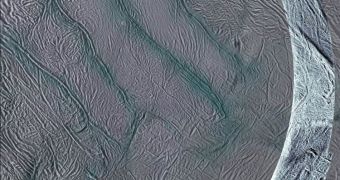The NASA Cassini orbiter recently managed to snap a new series of photos covering the Saturnine moon Enceladus, and the results were somewhat surprising to astronomers. They discovered the that object's surface displays a glow that was not apparent to Cassini until just now.
The spacecraft was able to see it because it used its synthetic aperture radar (SAR) instrument to conduct the new observations session. This is the first time it uses this capabilities for studying Enceladus, since the use of SAR is generally reserved for studying Saturn itself.
While browsing the data Cassini relayed back to Earth, mission controllers at the NASA Jet Propulsion Laboratory (JPL), in Pasadena, California, identified a series of unexpected textures in the ice, that visible-light images of the south pole never quite revealed.
Around the same area, the SAR instrument also revealed interesting grooves adorning the surface of Enceladus. The southern polar areas on this particular Saturnine moon are extremely interesting to astronomers because they contain the tiger stripe features.
These are patterns of cracks in the ice covering the moon, through which plumes of organic matter and water vapors are ejected from within Enceladus. These plumes contribute to fueling Saturn's E Ring, and also contributed to putting moisture in the gas giant's atmosphere.
JPL experts therefore wanted to obtain extremely clear images of the area. In order to do that, they decided to use SAR technologies. These are notoriously efficient at collecting high-resolution images. The observations session was carried out on November 6.
“It's puzzling why this is some of the brightest stuff Cassini has seen. One possibility is that the area is studded with rounded ice rocks. But we can't yet explain how that would happen,” says JPL Cassini radar team deputy leader Steve Wall.
One of the interesting aspects the new images hint at is that the weird brightness may be shared by several of Saturn's moons. Studies conducted by Cassini on Titan have revealed a similar occurrence in a landscape feature called Xanadu.
A number of regions surrounding the crater Sinlap – also on Titan – display remarkable levels of brightness to the SAR instrument as well. On Titan, however, visible-light instruments cannot be used, due to the fact that a thick, yellow atmosphere is obscuring all visibility in these wavelengths.
Cassini scientists now plan to extend their SAR observations on Enceladus during the next flybys the probe will carry out around the moon. The reason why this particular object is so interesting is that it may have an ocean of liquid water buried deep beneath the surface.

 14 DAY TRIAL //
14 DAY TRIAL //